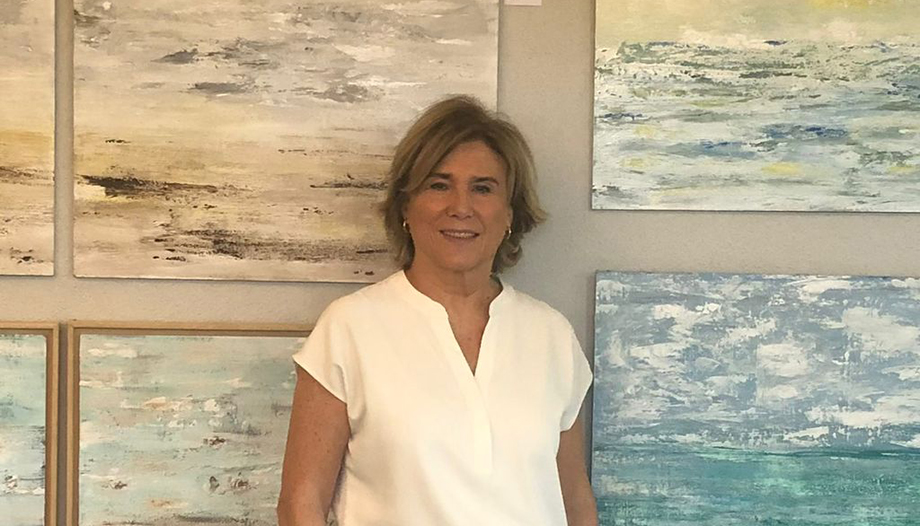









Carmen Abascal has constantly painted in both small and large formats, exploring different techniques and materials. He studied Fine Arts at the Complutense University in Madrid, although he has been dedicated for many years to communication. But he has been intensely active as an artist for some time now.
In October last year she held an "open house", and says she is "quite happy because people like my work: I have sold quite a lot and I have also had commissions". It is true, she says, that her painting is very well aligned with the aesthetics of today. Among other themes, she likes "the horizon as a connection, as a bridge between heaven and earth, as harmony, which reflects man's aspiration towards the transcendent, which I am convinced is within each person".
Her last exhibition was in Puerto de Santa Maria, in Puerto Sherry. Now, Carmen Abascal is working on several projects to be presented in different fairs, both in Spain and abroad, which she is simultaneously working on with her company.
Where were you born and educated? Where did you start your activity?
-I am from Tudela and I studied Fine Arts at the Complutense University. I directed a leisure time association for children, launching a musical comedy contest, in which creativity applied to scenery and costumes, in addition to dance and music, had a decisive role. The National Musical Comedy Contest project achieved great prestige throughout the national territory, with participants from different Spanish regions. Then I worked in an auction company.
His sensibility for art, for beauty, arose at a very young age...
-I have always had it, since I was a child, I have always liked it very much. I see that the human being has that aesthetic need, which is not a whim, but a need, a universal human being closely linked to goodness, ethics and aesthetics are closely linked, say many philosophers and I experience it every day. For me, painting is an aesthetic experience, but I want to share it with the person who sees my work. I believe that we all have the right to beauty, which makes us better. I don't know if it is very idealistic, but I am absolutely convinced that this is so. I just read a novel "An Enchanted April", by the Australian Elizabeth von Arnim, which is a hymn to beauty and goodness, and precisely the character who stands out for her goodness is the one who craves beauty the most, in that novel. Besides, I have cultivated a lot of art, visits to museums, exhibitions, etc.
Let's talk about Tàpies and sand... What else has influenced you?
-It's not only Tápies. The movement of the 60's of Spanish painters working with materials has always attracted me a lot. For example, I also have a lot of work with wood, Lucio Muñoz worked a lot with wood, I have work I do with notebooks... I have always liked to recycle. Now that sustainability is on the rise, I have always worked with recycled material as an artistic expression. Sand gives me a lot of versatility to express the connection with nature in different territories, in the sea, in the sky, in volcanoes, in the earth, in mud, in stone, etc.
He admires and is fascinated by nature...
-I like to go to the mountains, to the countryside. I need it to disconnect by connecting with beauty.
You like the horizon very much.
-Another line of work I have, because I have always been motivated by the horizon. Whether at sea, in the field, on land, I like to think that we are with our feet on the ground, but looking at the sky....
What about colors, what do they bring to you, what are you looking for in your painting?
-The colors found in nature attract me, they bring balance and peace, something so necessary in these times of aggressiveness. With this line I look for peace, serenity. Many people comment that my work gives them peace, and on the other hand, many clients ask me for paintings that bring serenity, it is clear that these are values that we are all looking for. I believe that beauty brings a transcendental value that leads us to the truth, to the good, more than the vindication of art as an expression of life in which the ugly is shown. Maybe I am more of a dreamer in that sense.
Let's wrap it up. You talk about a series on connected. What do you mean?
-For many years I have worked with "connected". An artist needs to express his creative expression in different ways, and you evolve. Now I am working more with material expressions, with horizons, and more expressionistic thematic series. I have just made a botanical garden, with greens, a lot of expression of nature, bushes, trees...
"Conectados" was a series influenced by Gerardo Rueda. I spent a long time doing that work, I called it connected because it united blocks of different sizes that could be different communities. For me they were like a reminder that can help us, we are all connected, in the family, at work, in civil society, I wanted to think about positive and collaborative connected communities, which also has a solidarity aspect.
Is beauty a right? It is a phrase of his.
-I think so. It is a universal, something that is within man, to aspire to beauty, a thing that we all must experience from the depths of our being, very much connected with goodness, to which we all have a right and which makes us better. To experience a sunny afternoon, a sunrise, a generous act of a child with an old man are beautiful facts that widen our hearts... all of us.












